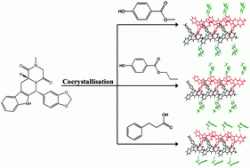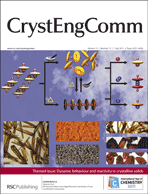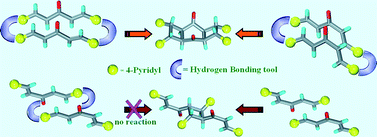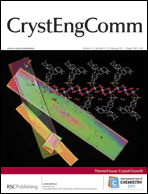
Pharmaceutical cocrystals of tadalafil with methylparaben, propylparaben and hydrocinnamic acid were investigated.
A team from the United States report their study on the hydrogen bonding motifs in tadalafil cocrystals with the aim to produce a drug with enhanced solubility for better oral drug absorption. Tadalafil, currently used for the treatment of erectile dysfunction, is being explored as a treatment for pulmonary arterial hypertension so would be more useful for this application if the time taken to reach its peak plasma concentration was shorter.
To find out more, download this CrystEngComm communication today…
Crystal engineering of multiple-component organic solids: Pharmaceutical cocrystals of tadalafil with persistent hydrogen bonding motifs
David R. Weyna, Miranda L. Cheney, Ning Shan, Mazen Hanna, Lukasz Wojtas and Michael J. Zaworotko
CrystEngComm, 2012
DOI: 10.1039/C2CE06574F
The communication by Zaworotko et al. will be published later in the year as part of a themed issue on crystal engineering in the pharmaceutical industry. Below is a selection of papers also due to be included in this themed issue:
Covalent assistance to supramolecular synthesis: modifying the drug functionality of the antituberculosis API isoniazid in situ during co-crystallization with GRAS and API compounds
Andreas Lemmerer
CrystEngComm, 2012
DOI: 10.1039/C1CE06310C
Effect of dehydration on the mechanical properties of sodium saccharin dihydrate probed with nanoindentation
M. S. R. N. Kiran, Sunil Varughese, U. Ramamurty and Gautam R. Desiraju
CrystEngComm, 2012
DOI: 10.1039/C1CE05656E
Solid state chemistry of the antibiotic doxycycline: structure of the neutral monohydrate and insights into its poor water solubility
Alexandre O. Legendre, Laila R. R. Silva, Douglas M. Silva, Iara M. L. Rosa, Lilian C. Azarias, Polyana J. de Abreu, Magali B. de Araújo, Person P. Neves, Claudia Torres, Felipe T. Martins and Antonio C. Doriguetto
CrystEngComm, 2012
DOI: 10.1039/C1CE06181J











 CrystEngComm‘s themed issue on
CrystEngComm‘s themed issue on  A double [2 + 2] photochemical reaction of 1,5-bis(4-pyridyl)-1,4-pentadiene-3-one (1P) was observed with in four co-crystal forms of 1P with the hydrogen bonding template molecule phloroglucinol (PG) or 5-methoxy resorcinol (MR). 1H NMR and the UV-vis spectroscopic studies established a stepwise mechanism for this reaction through the formation of a monocyclobutane intermediate.
A double [2 + 2] photochemical reaction of 1,5-bis(4-pyridyl)-1,4-pentadiene-3-one (1P) was observed with in four co-crystal forms of 1P with the hydrogen bonding template molecule phloroglucinol (PG) or 5-methoxy resorcinol (MR). 1H NMR and the UV-vis spectroscopic studies established a stepwise mechanism for this reaction through the formation of a monocyclobutane intermediate.
